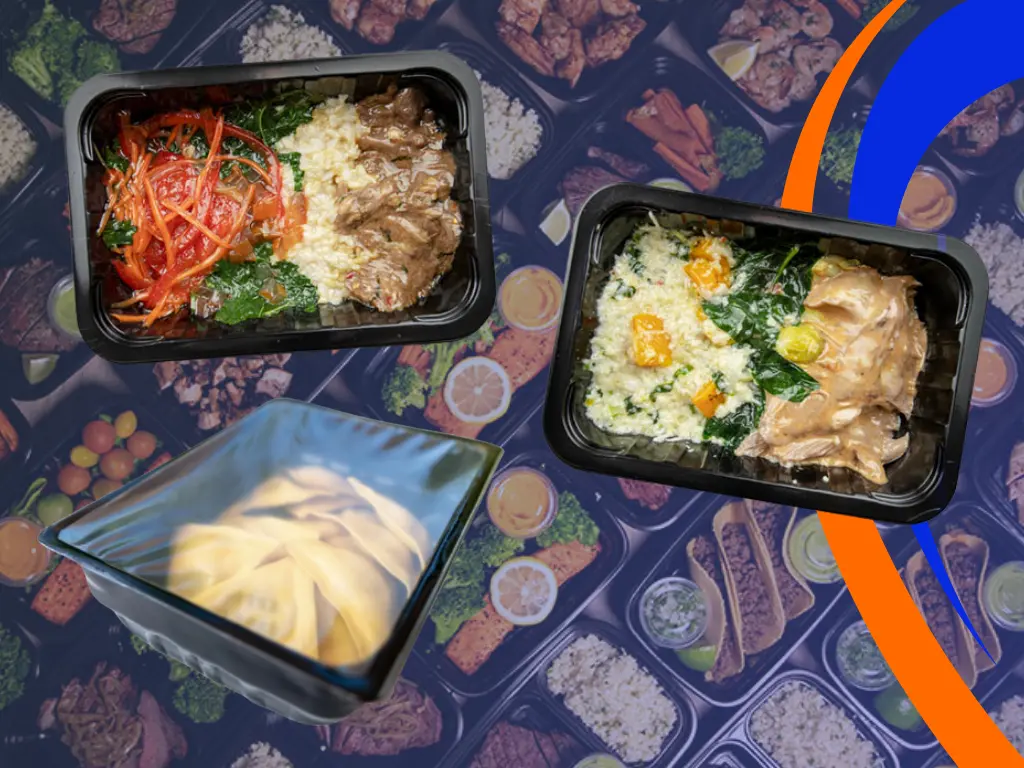
Choosing the right food packaging tray might seem straightforward, but there’s more to consider than just convenience and cost. PP, PP/PE, and PET trays each offer unique benefits suited to specific food types, sealing methods, and sustainability goals, but how do you know which one is right for you?
At DFC Packaging, we’re here to clear up the confusion about polypropylene packaging, polyethylene packaging, and PET plastic packaging, so you can make the best choice for your products.
What Are PP, PP/PE, and PET Trays?
Before diving into differences, here’s a quick overview of these commonly used tray materials.
PP Trays (Polypropylene Trays)
These trays are popular for their microwave-safe properties and recyclability. A PP food tray is commonly used in ready-meal applications across Australian food production.
PP/PE Trays (Polypropylene Base with Polyethylene Sealing Layer)
These trays combine polypropylene and polyethylene layers to offer superior sealing capabilities, ideal for MAP and vacuum sealing. The addition of PE plastic packaging helps support stronger heat sealing and barrier protection.
PET Trays (Polyethylene Terephthalate Trays)
Known for their strength, clarity, and recyclability, polyethylene terephthalate packaging is commonly used for fresh produce and cold foods.
PP Plastic Packaging Explained
Polypropylene trays, or PP trays, are widely used in food manufacturing, especially for ready meals, soups, and sauces.
Pros of PP Trays:
- Microwave-safe: Excellent for convenience foods and meals that require reheating.
- Recyclable: PP trays can be easily recycled through Australian polypropylene plastic tray streams.
- Cost-effective: Ideal for large-scale production without high overhead costs.
Cons of PP Packaging:
- Less rigid: PP trays lack the rigidity and clarity of PET trays.
- Specific sealing requirements: May need dedicated sealing equipment to ensure a reliable seal.
Understanding PP/PE Packaging
PP/PE trays are designed with an additional polyethylene layer, enhancing sealing capabilities and barrier performance. They’re ideal for vacuum-sealed fresh products like pasta, meats, and seafood.
Pros of PP/PE Trays:
- Excellent heat-seal compatibility: Perfect for Modified Atmosphere Packaging (MAP) and vacuum sealing.
- Superior clarity: Great for displaying food clearly, enhancing consumer appeal.
- Extended shelf life: Reliable seals maintain freshness and protect against contamination.
Cons of PP/PE Trays:
- Recyclability challenges: Mixed materials make these trays less straightforward to recycle compared to mono-material trays.
PET Packaging: Strong and Sustainable
PET plastic packaging is popular for its robustness and exceptional clarity, making it perfect for fresh fruits and vegetables, chilled foods, and bakery items.
Pros of PET Trays:
- High clarity: Offers excellent product visibility, ideal for retail presentation.
- Strength and rigidity: PET trays protect delicate items and maintain structural integrity during transport.
- Fully recyclable: PET trays are easily recycled in dedicated PET streams in Australia.
Cons of PET Trays:
- Not microwave-safe: PET trays can warp under heat, limiting their use for reheatable products.
- Brittleness: More susceptible to cracking under stress compared to PP and PP/PE trays.
How to Select the Right Tray For Your Operations
Choosing between PP trays, PP/PE trays, and PET trays depends heavily on your product, packaging process, and sustainability objectives. Here are essential factors to consider:
- Food Type: Is your product fresh, frozen, chilled, or ready-to-heat?
- Sealing Method: Do you require MAP, vacuum sealing, or heat-sealing capabilities?
- Microwave Usage: Will the end consumer need to heat the product directly in the tray?
- Recyclability Goals: Is meeting recyclability and sustainability targets a priority for your business?
You may also need to consider specific applications such as polyethylene trays for cold storage or PET trays for high-clarity product display in retail environments.
Your Trusted Source for PP, PP/PE, and PET Trays
At DFC Packaging, we specialise in locally-made, APCO-compliant tray solutions tailored to your business needs. With our film, sleeve, and machinery supply capabilities, we offer shorter lead times compared to overseas suppliers, ensuring you get your trays exactly when you need them.
Our team provides personalised guidance, making sure your tray selection perfectly matches your product requirements, automation processes, and sustainability goals. Plus, our trays are designed to support recyclability, helping you reduce plastic usage without sacrificing performance.
Take the Next Step with DFC Packaging
Ready to find the perfect packaging solution for your products? DFC Packaging offers free consultations, product compatibility reviews, and sustainable tray options that align with your business and environmental objectives.
Call (03) 9701 2000 or get in touch online to request a sample pack or book your packaging review. Together, we’ll ensure your packaging not only protects your product but also supports your sustainability goals.





